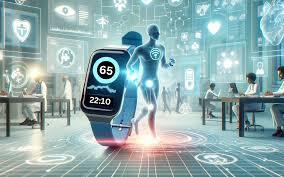Wearable health devices, also known as wearables, are innovative technologies designed to monitor health and fitness metrics continuously. This article explores the fundamentals, types, applications, benefits, challenges, and future trends of wearable health devices, highlighting their transformative impact on personal health monitoring and healthcare management.
Fundamentals of Wearable Health Devices
Wearable health devices are small electronic devices equipped with sensors and connectivity features that collect and transmit data about physiological parameters and activities. Key components include:
- Sensors: Devices incorporate various sensors such as accelerometers, heart rate monitors, GPS, temperature sensors, and bioimpedance sensors to capture real-time data.
- Data Collection: Continuous monitoring and collection of health metrics including heart rate, blood pressure, sleep patterns, physical activity, calories burned, and stress levels.
- Connectivity: Integration with smartphones, tablets, or dedicated apps via Bluetooth, Wi-Fi, or cellular networks to transmit data and provide real-time feedback.
- User Interface: Display screens or interfaces on the device or companion apps for users to view data, set goals, track progress, and receive alerts or notifications.
Types of Wearable Health Devices
- Fitness Trackers: Devices focused on monitoring physical activity, steps taken, distance traveled, calories burned, and sleep patterns to promote active lifestyles.
- Smartwatches: Combining fitness tracking features with additional functionalities such as notifications, GPS navigation, and integration with smartphone apps.
- Medical Wearables: Devices prescribed or used in clinical settings to monitor specific health conditions like glucose levels (continuous glucose monitors), cardiac activity (ECG monitors), or respiratory metrics.
- Smart Clothing: Incorporating sensors into garments or accessories (e.g., shirts, socks, headbands) to monitor biometric data discreetly and comfortably.
Applications of Wearable Health Devices
- Personal Health Monitoring: Tracking daily activity levels, sleep quality, heart rate variability, and stress levels to promote overall wellness and fitness.
- Chronic Disease Management: Monitoring vital signs and symptoms in patients with chronic conditions such as diabetes, hypertension, or heart disease to facilitate early intervention and remote patient monitoring.
- Fitness and Sports Performance: Providing athletes and fitness enthusiasts with real-time feedback on performance metrics, recovery time, and training intensity.
- Remote Patient Monitoring: Enabling healthcare providers to remotely monitor patients’ health metrics, adherence to treatment plans, and detect early signs of health deterioration.
Benefits of Wearable Health Devices
- Continuous Monitoring: Providing real-time insights into health metrics, enabling proactive management of health conditions and lifestyle adjustments.
- Empowerment and Engagement: Encouraging users to take an active role in their health by setting goals, tracking progress, and receiving personalized feedback.
- Early Detection and Intervention: Facilitating early detection of health issues or abnormalities, potentially preventing complications and reducing healthcare costs.
- Data-Driven Insights: Generating comprehensive data analytics for healthcare professionals to personalize treatment plans, improve clinical outcomes, and patient satisfaction.
Challenges in Wearable Health Devices
- Data Accuracy and Reliability: Ensuring accurate measurement of health metrics across diverse user demographics, activities, and environmental conditions.
- Privacy and Security: Protecting sensitive health data from unauthorized access, breaches, and complying with regulatory standards (e.g., HIPAA, GDPR).
- User Adoption and Engagement: Encouraging sustained use and adherence to wearable devices, addressing user preferences, comfort, and usability concerns.
- Integration with Healthcare Systems: Integrating wearable data into electronic health records (EHRs), ensuring interoperability with existing healthcare IT infrastructure, and facilitating data exchange between devices and healthcare providers.
Future Trends in Wearable Health Devices
- Advanced Sensor Technology: Incorporating more advanced sensors for continuous monitoring of additional health parameters, such as blood oxygen levels, hydration status, and biochemical markers.
- AI and Machine Learning: Enhancing predictive analytics capabilities to provide personalized health insights, early disease detection, and adaptive coaching based on user data.
- Wearable ECG and Health Diagnosis: Developing wearable devices capable of performing real-time ECG monitoring, arrhythmia detection, and early warning systems for cardiovascular health.
- Integration with Telemedicine: Combining wearable devices with telemedicine platforms for remote consultations, virtual healthcare visits, and seamless patient monitoring.
Conclusion
Wearable health devices represent a significant advancement in personalized healthcare, empowering individuals to monitor their health proactively and enabling healthcare professionals to deliver more personalized and efficient care. As technology continues to evolve and consumer demand grows, addressing challenges related to data accuracy, privacy, user engagement, and integration with healthcare systems will be crucial. By leveraging emerging technologies, fostering collaboration between stakeholders, and prioritizing user-centric design, wearable health devices are poised to revolutionize healthcare delivery and promote wellness in the digital age.
